The Acute Effects of 25- Versus 60-Minute Naps on Agility and Vertical Jump Performance in Elite Youth Soccer Players: The Role of Individual Chronotype
Abstract
1. Introduction
2. Materials and Methods
2.1. Research Model
2.2. Participants
2.3. Experimental Design
2.4. Data Collection
2.4.1. Anthropometric Measurements
2.4.2. Morningness-Eveningness Questionnaire
2.4.3. The Pittsburgh Sleep Quality Index (PSQI)
2.4.4. Profile of Mood States Questionnaire (PMSQ)
2.4.5. Hooper Questionnaire
2.4.6. Visual Analog Scale (VAS)
2.4.7. Countermovement Jump Test (CMJ)
2.4.8. Illinois Agility Test
2.4.9. The Illinois Change-of-Direction Test with Ball
2.5. Statistical Analysis
3. Results
4. Discussion
5. Conclusions
Author Contributions
Funding
Institutional Review Board Statement
Informed Consent Statement
Data Availability Statement
Acknowledgments
Conflicts of Interest
References
- Faraut, B.; Andrillon, T.; Vecchierini, M.-F.; Leger, D. Napping: A public health issue. From epidemiological to laboratory studies. Sleep Med. Rev. 2017, 35, 85–100. [Google Scholar] [CrossRef] [PubMed]
- Halson, S.L. Sleep Monitoring in Athletes: Motivation, Methods, Miscalculations and Why it Matters. Sports Med. 2019, 49, 1487–1497. [Google Scholar] [CrossRef] [PubMed]
- Vitale, J.A.; Banfi, G.; La Torre, A.; Bonato, M. Effect of a Habitual Late-Evening Physical Task on Sleep Quality in Neither-Type Soccer Players. Front. Physiol. 2018, 9, 1582. [Google Scholar] [CrossRef] [PubMed]
- Ferrara, M.; De Gennaro, L. How much sleep do we need? Sleep Med. Rev. 2001, 5, 155–179. [Google Scholar] [CrossRef]
- Hirshkowitz, M.; Whiton, K.; Albert, S.M.; Alessi, C.; Bruni, O.; DonCarlos, L.; Hazen, N.; Herman, J.; Adams Hillard, P.J.; Katz, E.S.; et al. National Sleep Foundation’s updated sleep duration recommendations: Final report. Sleep Health 2015, 1, 233–243. [Google Scholar] [CrossRef]
- Mah, C.D.; Mah, K.E.; Kezirian, E.J.; Dement, W.C. The Effects of Sleep Extension on the Athletic Performance of Collegiate Basketball Players. Sleep 2011, 34, 943–950. [Google Scholar] [CrossRef]
- Sargent, C.; Lastella, M.; Halson, S.L.; Roach, G.D. The impact of training schedules on the sleep and fatigue of elite athletes. Chronobiol. Int. 2014, 31, 1160–1168. [Google Scholar] [CrossRef]
- Fietze, I.; Strauch, J.; Holzhausen, M.; Glos, M.; Theobald, C.; Lehnkering, H.; Penzel, T. Sleep Quality in Professional Ballet Dancers. Chronobiol. Int. 2009, 26, 1249–1262. [Google Scholar] [CrossRef]
- Leeder, J.; Glaister, M.; Pizzoferro, K.; Dawson, J.; Pedlar, C. Sleep duration and quality in elite athletes measured using wristwatch actigraphy. J. Sports Sci. 2012, 30, 541–545. [Google Scholar] [CrossRef]
- Tietzel, A.J.; Lack, L.C. The recuperative value of brief and ultra-brief naps on alertness and cognitive performance. J. Sleep Res. 2002, 11, 213–218. [Google Scholar] [CrossRef]
- Watson, A.M. Sleep and Athletic Performance. Curr. Sports Med. Rep. 2017, 16, 413–418. [Google Scholar] [CrossRef] [PubMed]
- Nishida, M.; Okano, S.; Ichinose, A.; Suyama, S.; Youn, S. Daytime Napping Benefits Passing Performance and Scanning Activity in Elite Soccer Players. J. Sports Sci. Med. 2023, 22, 75–83. [Google Scholar] [CrossRef] [PubMed]
- Erlacher, D.; Ehrlenspiel, F.; Adegbesan, O.A.; Galal El-Din, H. Sleep habits in German athletes before important competitions or games. J. Sports Sci. 2011, 29, 859–866. [Google Scholar] [CrossRef]
- Fullagar, H.; Skorski, S.; Duffield, R.; Meyer, T. The effect of an acute sleep hygiene strategy following a late-night soccer match on recovery of players. Chronobiol. Int. 2016, 33, 490–505. [Google Scholar] [CrossRef]
- Skein, M.; Duffield, R.; Minett, G.M.; Snape, A.; Murphy, A. The Effect of Overnight Sleep Deprivation After Competitive Rugby League Matches on Postmatch Physiological and Perceptual Recovery. Int. J. Sports Physiol. Perform. 2013, 8, 556–564. [Google Scholar] [CrossRef]
- Jarraya, S.; Jarraya, M.; Chtourou, H.; Souissi, N. Effect of time of day and partial sleep deprivation on the reaction time and the attentional capacities of the handball goalkeeper. Biol. Rhythm Res. 2014, 45, 183–191. [Google Scholar] [CrossRef]
- Mougin, F.; Simon-Rigaud, M.L.; Davenne, D.; Renaud, A.; Garnier, A.; Kantelip, J.P.; Magnin, P. Effects of sleep disturbances on subsequent physical performance. Eur. J. Appl. Physiol. Occup. Physiol. 1991, 63, 77–82. [Google Scholar] [CrossRef]
- Abedelmalek, S.; Chtourou, H.; Aloui, A.; Aouichaoui, C.; Souissi, N.; Tabka, Z. Effect of time of day and partial sleep deprivation on plasma concentrations of IL-6 during a short-term maximal performance. Eur. J. Appl. Physiol. 2013, 113, 241–248. [Google Scholar] [CrossRef]
- Clemente, F.M.; Afonso, J.; Costa, J.; Oliveira, R.; Pino-Ortega, J.; Rico-González, M. Relationships between Sleep, Athletic and Match Performance, Training Load, and Injuries: A Systematic Review of Soccer Players. Healthcare 2021, 9, 808. [Google Scholar] [CrossRef]
- Fullagar, H.H.K.; Duffield, R.; Skorski, S.; Coutts, A.J.; Julian, R.; Meyer, T. Sleep and Recovery in Team Sport: Current Sleep-Related Issues Facing Professional Team-Sport Athletes. Int. J. Sports Physiol. Perform. 2015, 10, 950–957. [Google Scholar] [CrossRef]
- Vitale, J.A.; Weydahl, A. Chronotype, Physical Activity, and Sport Performance: A Systematic Review. Sports Med. 2017, 47, 1859–1868. [Google Scholar] [CrossRef] [PubMed]
- Roenneberg, T.; Wirz-Justice, A.; Merrow, M. Life between clocks: Daily temporal patterns of human chronotypes. J. Biol. Rhythm. 2003, 18, 80–90. [Google Scholar] [CrossRef] [PubMed]
- Adan, A.; Archer, S.N.; Hidalgo, M.P.; Di Milia, L.; Natale, V.; Randler, C. Circadian typology: A comprehensive review. Chronobiol. Int. 2012, 29, 1153–1175. [Google Scholar] [CrossRef] [PubMed]
- Brown, F.M.; Neft, E.E.; LaJambe, C.M. Collegiate Rowing Crew Performance Varies by Morningness-Eveningness. J. Strength Cond. Res. 2008, 22, 1894–1900. [Google Scholar] [CrossRef]
- Rae, D.E.; Stephenson, K.J.; Roden, L.C. Factors to consider when assessing diurnal variation in sports performance: The influence of chronotype and habitual training time-of-day. Eur. J. Appl. Physiol. 2015, 115, 1339–1349. [Google Scholar] [CrossRef]
- Gupta, L.; Morgan, K.; North, C.; Gilchrist, S. Napping in high-performance athletes: Sleepiness or sleepability? Eur. J. Sport Sci. 2021, 21, 321–330. [Google Scholar] [CrossRef]
- Lastella, M.; Halson, S.L.; Vitale, J.A.; Memon, A.R.; Vincent, G.E. To Nap or Not to Nap? A Systematic Review Evaluating Napping Behavior in Athletes and the Impact on Various Measures of Athletic Performance. Nat. Sci. Sleep 2021, 13, 841–862. [Google Scholar] [CrossRef]
- Hsouna, H.; Boukhris, O.; Hill, D.W.; Abdessalem, R.; Trabelsi, K.; Ammar, A.; Taheri, M.; Hammouda, O.; Clark, C.C.T.; Driss, T.; et al. A daytime 40-min nap opportunity after a simulated late evening soccer match reduces the perception of fatigue and improves 5-m shuttle run performance. Res. Sports Med. 2022, 30, 502–515. [Google Scholar] [CrossRef]
- Ajjimaporn, A.; Ramyarangsi, P.; Siripornpanich, V. Effects of a 20-min Nap after Sleep Deprivation on Brain Activity and Soccer Performance. Int. J. Sports Med. 2020, 41, 1009–1016. [Google Scholar] [CrossRef]
- Faul, F.; Erdfelder, E.; Lang, A.-G.; Buchner, A. G*Power 3: A flexible statistical power analysis program for the social, behavioral, and biomedical sciences. Behav. Res. Methods 2007, 39, 175–191. [Google Scholar] [CrossRef]
- Souabni, M.; Souabni, M.J.; Hidouri, S.; Ammar, A.; Younes, M.; Hammouda, O.; Driss, T. Napping and heart rate variability in elite athletes. Biol. Sport 2024, 41, 213–221. [Google Scholar] [CrossRef] [PubMed]
- Kaida, K.; Takahashi, M.; Otsuka, Y. A Short Nap and Natural Bright Light Exposure Improve Positive Mood Status. Ind. Health 2007, 45, 301–308. [Google Scholar] [CrossRef] [PubMed]
- Stowe, S.R.; LeBourgeois, M.K.; Diniz Behn, C. Modeling the Effects of Napping and Non-napping Patterns of Light Exposure on the Human Circadian Oscillator. J. Biol. Rhythm. 2023, 38, 492–509. [Google Scholar] [CrossRef]
- Boukhris, O.; Abdessalem, R.; Ammar, A.; Hsouna, H.; Trabelsi, K.; Engel, F.A.; Sperlich, B.; Hill, D.W.; Chtourou, H. Nap Opportunity During the Daytime Affects Performance and Perceived Exertion in 5-m Shuttle Run Test. Front. Physiol. 2019, 10, 779. [Google Scholar] [CrossRef]
- Sales, M.M.; Maciel, A.P.; da Silva Aguiar, S.; Asano, R.Y.; Motta-Santos, D.; de Moraes, J.F.V.N.; Alves, P.M.; Santos, P.A.; Barbosa, L.P.; Ernesto, C.; et al. Vertical Jump Is Strongly Associated to Running-Based Anaerobic Sprint Test in Teenage Futsal Male Athletes. Sports 2018, 6, 129. [Google Scholar] [CrossRef]
- Di Milia, L.; Adan, A.; Natale, V.; Randler, C. Reviewing the Psychometric Properties of Contemporary Circadian Typology Measures. Chronobiol. Int. 2013, 30, 1261–1271. [Google Scholar] [CrossRef]
- Horne, J.A.; Ostberg, O. A self-assessment questionnaire to determine morningness-eveningness in human circadian rhythms. Int. J. Chronobiol. 1976, 4, 97–110. [Google Scholar]
- Núñez, P.; Perillan, C.; Arguelles, J.; Diaz, E. Comparison of sleep and chronotype between senior and undergraduate university students. Chronobiol. Int. 2019, 36, 1626–1637. [Google Scholar] [CrossRef]
- You, Y. Accelerometer-measured physical activity and sedentary behaviour are associated with C-reactive protein in US adults who get insufficient sleep: A threshold and isotemporal substitution effect analysis. J. Sports Sci. 2024, 42, 527–536. [Google Scholar] [CrossRef]
- Buysse, D.J.; Reynolds, C.F.; Monk, T.H.; Berman, S.R.; Kupfer, D.J. The Pittsburgh sleep quality index: A new instrument for psychiatric practice and research. Psychiatry Res. 1989, 28, 193–213. [Google Scholar] [CrossRef]
- Reigal, R.E.; Vázquez-Diz, J.A.; Morillo-Baro, J.P.; Hernández-Mendo, A.; Morales-Sánchez, V. Psychological Profile, Competitive Anxiety, Moods and Self-Efficacy in Beach Handball Players. Int. J. Environ. Res. Public Health 2019, 17, 241. [Google Scholar] [CrossRef] [PubMed]
- Selvi, Y.; Gulec, M.; Aydin, A.; Besiroglu, L. Psychometric evaluation of the Turkish language version of the Profile of Mood States (POMS). J. Mood Disord. 2011, 1, 152. [Google Scholar] [CrossRef]
- Hooper, S.L.; Mackinnon, L.T.; Howard, A.; Gordon, R.D.; Bachmann, A.W. Markers for monitoring overtraining and recovery. Med. Sci. Sports Exerc. 1995, 27, 106–112. [Google Scholar] [CrossRef] [PubMed]
- Selmi, O.; Ouergui, I.; Castellano, J.; Levitt, D.; Bouassida, A. Effect of an intensified training period on well-being indices, recovery and psychological aspects in professional soccer players. Eur. Rev. Appl. Psychol. 2020, 70, 100603. [Google Scholar] [CrossRef]
- Torrance, G.W.; Feeny, D.; Furlong, W. Visual Analog Scales: Do They Have a Role in the Measurement of Preferences for Health States? Med. Decis. Mak. 2001, 21, 329–334. [Google Scholar] [CrossRef]
- Balsalobre-Fernández, C.; Glaister, M.; Lockey, R.A. The validity and reliability of an iPhone app for measuring vertical jump performance. J. Sports Sci. 2015, 33, 1574–1579. [Google Scholar] [CrossRef]
- Hachana, Y.; Chaabène, H.; Nabli, M.A.; Attia, A.; Moualhi, J.; Farhat, N.; Elloumi, M. Test-Retest Reliability, Criterion-Related Validity, and Minimal Detectable Change of the Illinois Agility Test in Male Team Sport Athletes. J. Strength Cond. Res. 2013, 27, 2752–2759. [Google Scholar] [CrossRef]
- Steff, N.; Badau, D.; Badau, A. Improving Agility and Reactive Agility in Basketball Players U14 and U16 by Implementing Fitlight Technology in the Sports Training Process. Appl. Sci. 2024, 14, 3597. [Google Scholar] [CrossRef]
- Bakdash, J.Z.; Marusich, L.R. Repeated Measures Correlation. Front. Psychol. 2017, 8, 456. [Google Scholar] [CrossRef]
- Batterham, A.M.; Hopkins, W.G. Making Meaningful Inferences About Magnitudes. Int. J. Sports Physiol. Perform. 2006, 1, 50–57. [Google Scholar] [CrossRef]
- Cohen, J. Statistical Power Analysis for the Behavioral Sciences, 2nd ed.; Lawrence Erlbaum: Hillsdale, NJ, USA, 1988. [Google Scholar]
- Hopkins, W.G.; Marshall, S.W.; Batterham, A.M.; Hanin, J. Progressive Statistics for Studies in Sports Medicine and Exercise Science. Med. Sci. Sports Exerc. 2009, 41, 3–12. [Google Scholar] [CrossRef] [PubMed]
- Daaloul, H.; Souissi, N.; Davenne, D. Effects of Napping on Alertness, Cognitive, and Physical Outcomes of Karate Athletes. Med. Sci. Sports Exerc. 2019, 51, 338–345. [Google Scholar] [CrossRef] [PubMed]
- Teece, A.R.; Beaven, C.M.; Argus, C.K.; Gill, N.; Driller, M.W. Daytime naps improve afternoon power and perceptual measures in elite rugby union athletes—A randomized cross-over trial. Sleep 2023, 46, zsad133. [Google Scholar] [CrossRef] [PubMed]
- Eken, Ö.; Bozkurt, O.; Türkmen, M.; Kurtoglu, A.; Alotaibi, M.H.; Elkholi, S.M. Post-Lunch Napping as a Strategy to Enhance Physiological Performance and Cognitive Function in Elite Volleyball Players. Medicina (B Aires) 2024, 60, 1698. [Google Scholar] [CrossRef]
- Blanchfield, A.W.; Lewis-Jones, T.M.; Wignall, J.R.; Roberts, J.B.; Oliver, S.J. The influence of an afternoon nap on the endurance performance of trained runners. Eur. J. Sport Sci. 2018, 18, 1177–1184. [Google Scholar] [CrossRef]
- Kurtoğlu, A.; Eken, Ö.; Aydın, E.; Çar, B.; Nobari, H. The impact of strategic napping on peak expiratory flow and respiratory function in young elite athletes. BMC Sports Sci. Med. Rehabil. 2024, 16, 41. [Google Scholar] [CrossRef]
- Bentouati, E.; Romdhani, M.; Abid, R.; Khemila, S.; Garbarino, S.; Souissi, N. The combined effects of napping and self-selected motivation music during warming up on cognitive and physical performance of karate athletes. Front. Physiol. 2023, 14, 1214504. [Google Scholar] [CrossRef]
- Petit, E.; Mougin, F.; Bourdin, H.; Tio, G.; Haffen, E. A 20-min nap in athletes changes subsequent sleep architecture but does not alter physical performances after normal sleep or 5-h phase-advance conditions. Eur. J. Appl. Physiol. 2014, 114, 305–315. [Google Scholar] [CrossRef]
- Boukhris, O.; Trabelsi, K.; Suppiah, H.; Ammar, A.; Clark, C.C.T.; Jahrami, H.; Chtourou, H.; Driller, M. The Impact of Daytime Napping Following Normal Night-Time Sleep on Physical Performance: A Systematic Review, Meta-analysis and Meta-regression. Sports Med. 2024, 54, 323–345. [Google Scholar] [CrossRef]
- O’Donnell, S.; Beaven, C.M.; Driller, M. The Influence of Match-Day Napping in Elite Female Netball Athletes. Int. J. Sports Physiol. Perform. 2018, 13, 1143–1148. [Google Scholar] [CrossRef]
- Romdhani, M.; Souissi, N.; Chaabouni, Y.; Mahdouani, K.; Driss, T.; Chamari, K.; Hammouda, O. Improved Physical Performance and Decreased Muscular and Oxidative Damage with Postlunch Napping After Partial Sleep Deprivation in Athletes. Int. J. Sports Physiol. Perform. 2020, 15, 874–883. [Google Scholar] [CrossRef] [PubMed]
- Tanabe, K.; Nakazato, K.; Noi, S. Effects of prophylactic naps on physical fitness/exercise ability and executive function in healthy young trained males. Biol. Rhythm Res. 2020, 51, 421–440. [Google Scholar] [CrossRef]
- Brooks, A.; Lack, L. A Brief Afternoon Nap Following Nocturnal Sleep Restriction: Which Nap Duration is Most Recuperative? Sleep 2006, 29, 831–840. [Google Scholar] [CrossRef]
- Shapiro, C.M.; Bortz, R.; Mitchell, D.; Bartel, P.; Jooste, P. Slow-Wave Sleep: A Recovery Period After Exercise. Science 1981, 214, 1253–1254. [Google Scholar] [CrossRef]
- Suppiah, H.T.; Low, C.Y.; Choong, G.; Chia, M. Effects of a Short Daytime Nap on Shooting and Sprint Performance in High-Level Adolescent Athletes. Int. J. Sports Physiol. Perform. 2019, 14, 76–82. [Google Scholar] [CrossRef]
- Botonis, P.G.; Koutouvakis, N.; Toubekis, A.G. The impact of daytime napping on athletic performance—A narrative review. Scand. J. Med. Sci. Sports 2021, 31, 2164–2177. [Google Scholar] [CrossRef]
- Eken, Ö.; Ceylan, H.İ.; Kurtoğlu, A.; Šimenko, J. The effect of time of day on Special Judo Fitness Test in active judokas: Evaluation in terms of chronotype. Chronobiol. Int. 2024, 41, 61–71. [Google Scholar] [CrossRef]
- Sirohi, P.; Khan, M.H.; Sharma, S.; Nuhmani, S.; Al Muslem, W.H.; Abualait, T. A systematic review of effects of daytime napping strategies on sports performance in physically active individuals with and without partial-sleep deprivation. PeerJ 2022, 10, e14460. [Google Scholar] [CrossRef]
- Petit, E.; Bourdin, H.; Tio, G.; Yenil, O.; Haffen, E.; Mougin, F. Effects of a 20-Min Nap Post Normal and Jet Lag Conditions on P300 Components in Athletes. Int. J. Sports Med. 2018, 39, 508–516. [Google Scholar] [CrossRef]
- Holst, S.C.; Landolt, H.-P. Sleep-Wake Neurochemistry. Sleep Med. Clin. 2022, 17, 151–160. [Google Scholar] [CrossRef]
- Waterhouse, J.; Atkinson, G.; Edwards, B.; Reilly, T. The role of a short post-lunch nap in improving cognitive, motor, and sprint performance in participants with partial sleep deprivation. J. Sports Sci. 2007, 25, 1557–1566. [Google Scholar] [CrossRef] [PubMed]
- Romdhani, M.; Hammouda, O.; Smari, K.; Chaabouni, Y.; Mahdouani, K.; Driss, T.; Souissi, N. Total Sleep Deprivation and Recovery Sleep Affect the Diurnal Variation of Agility Performance: The Gender Differences. J. Strength Cond. Res. 2021, 35, 132–140. [Google Scholar] [CrossRef] [PubMed]
- Vgontzas, A.N.; Pejovic, S.; Zoumakis, E.; Lin, H.M.; Bixler, E.O.; Basta, M.; Fang, J.; Sarrigiannidis, A.; Chrousos, G.P. Daytime napping after a night of sleep loss decreases sleepiness, improves performance, and causes beneficial changes in cortisol and interleukin-6 secretion. Am. J. Physiol. Endocrinol. Metab. 2007, 292, E253–E261. [Google Scholar] [CrossRef] [PubMed]
- Zamore, Z.; Goldschmied, J.; Deldin, P. 080 Is Napping Only Beneficial to Evening Chronotypes? A Pilot Study. Sleep 2021, 44, A33. [Google Scholar] [CrossRef]
- Fang, S.; Huang, C.; Wu, Y.; Wu, P.; Tsai, P. Effects of napping on cognitive function modulation in elderly adults with a morning chronotype: A nationwide survey. J. Sleep Res. 2019, 28, e12724. [Google Scholar] [CrossRef] [PubMed]
- Montaruli, A.; Castelli, L.; Mulè, A.; Scurati, R.; Esposito, F.; Galasso, L.; Roveda, E. Biological Rhythm and Chronotype: New Perspectives in Health. Biomolecules 2021, 11, 487. [Google Scholar] [CrossRef]
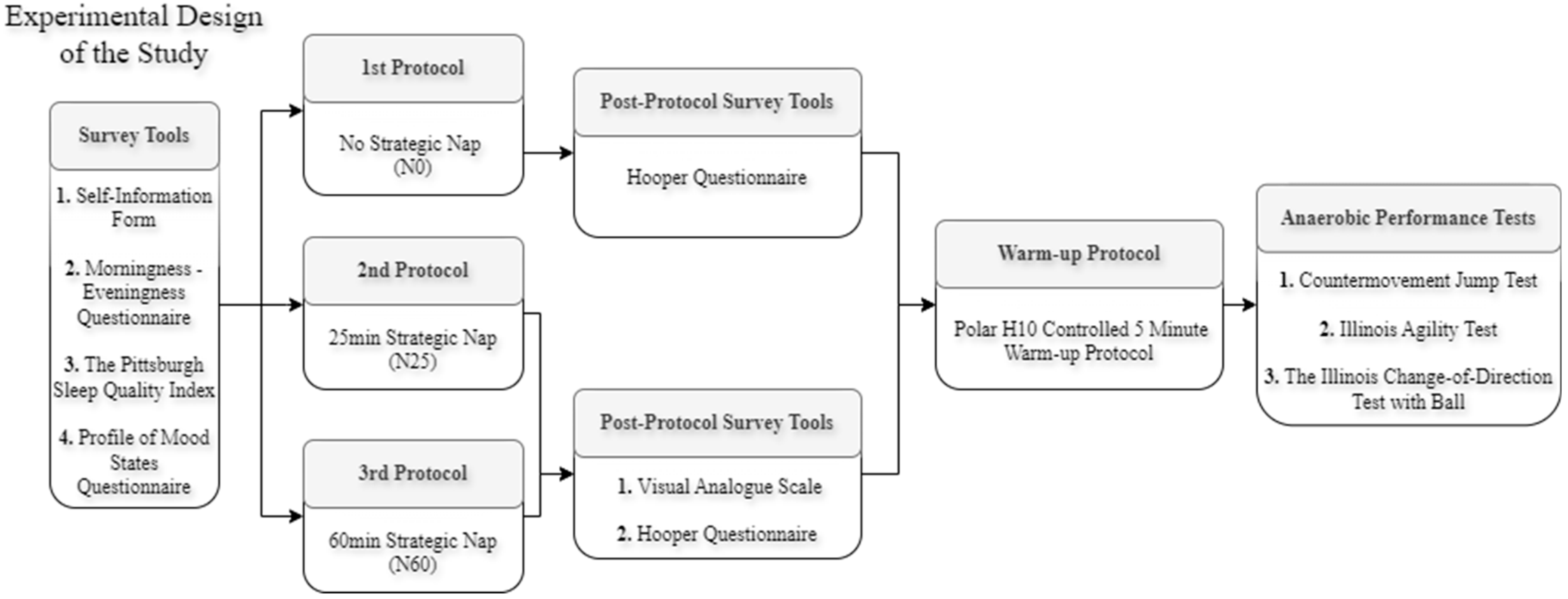
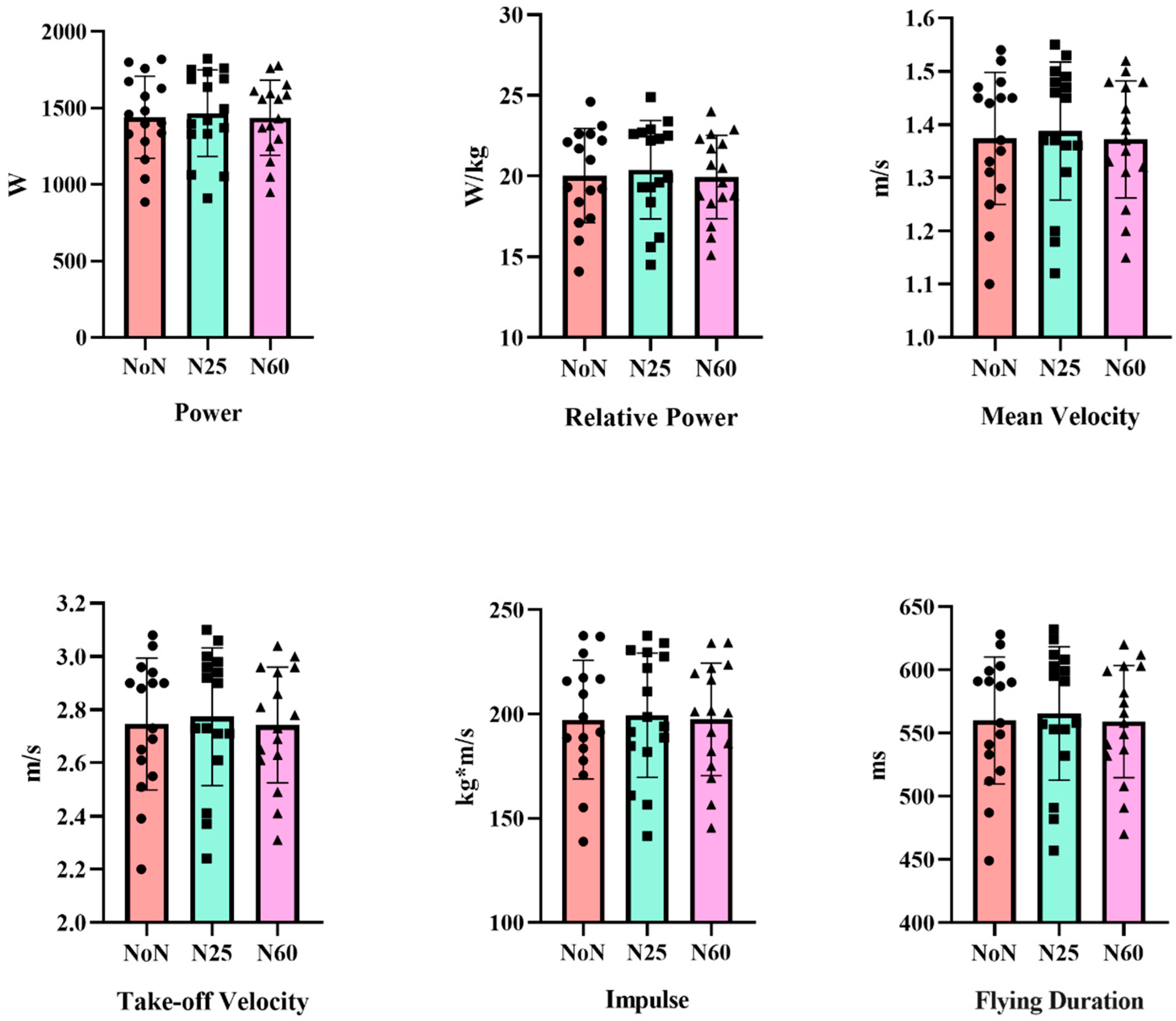
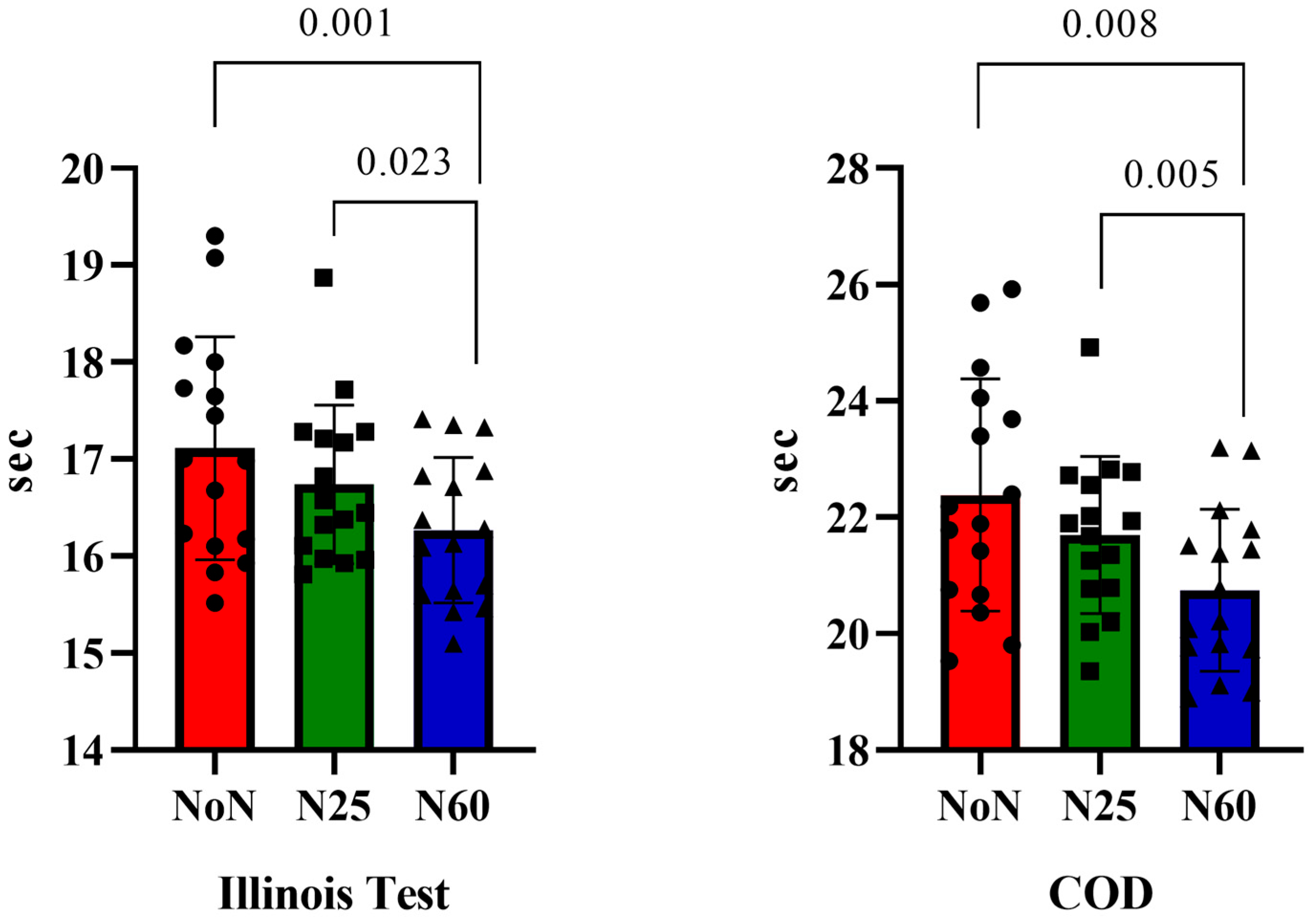
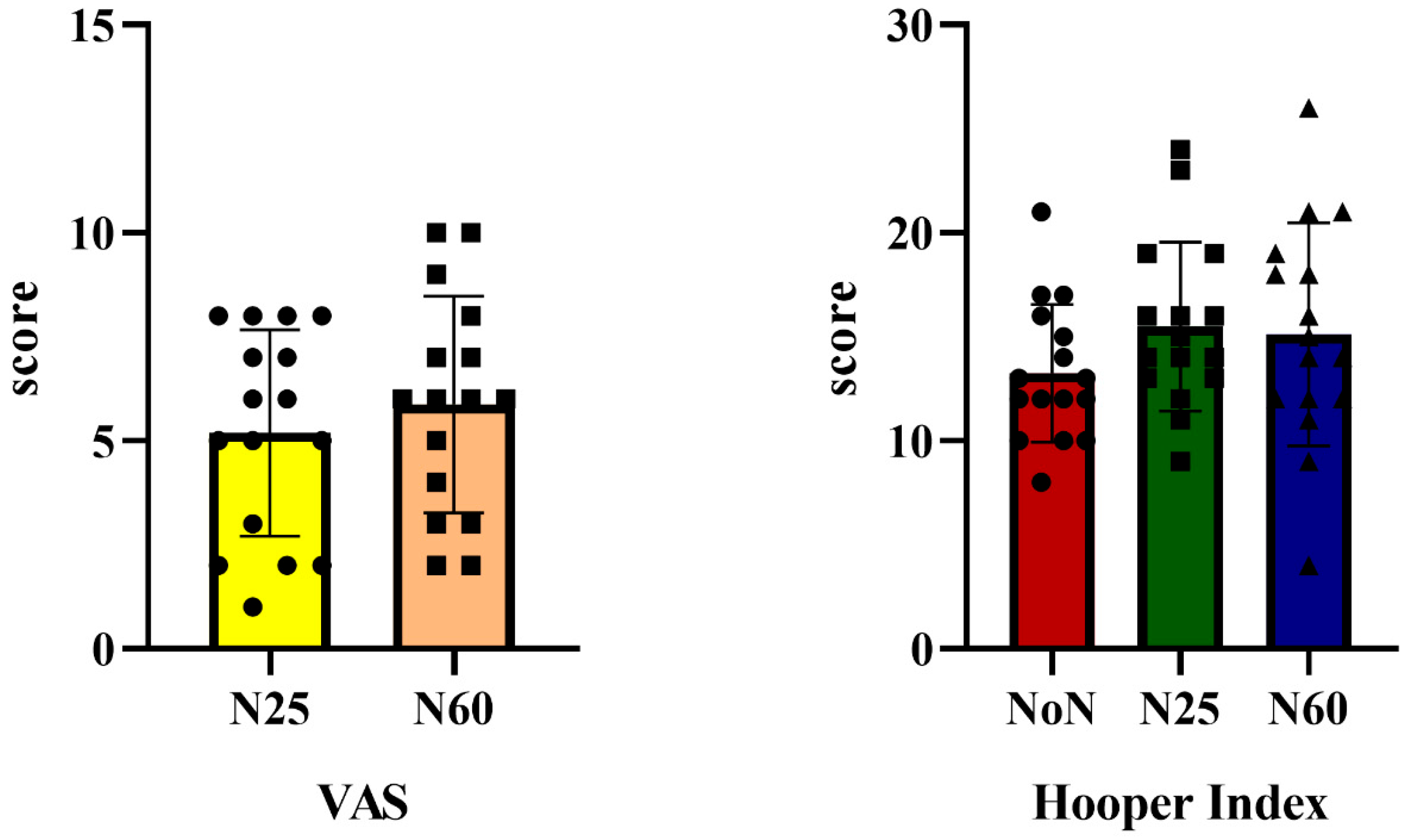

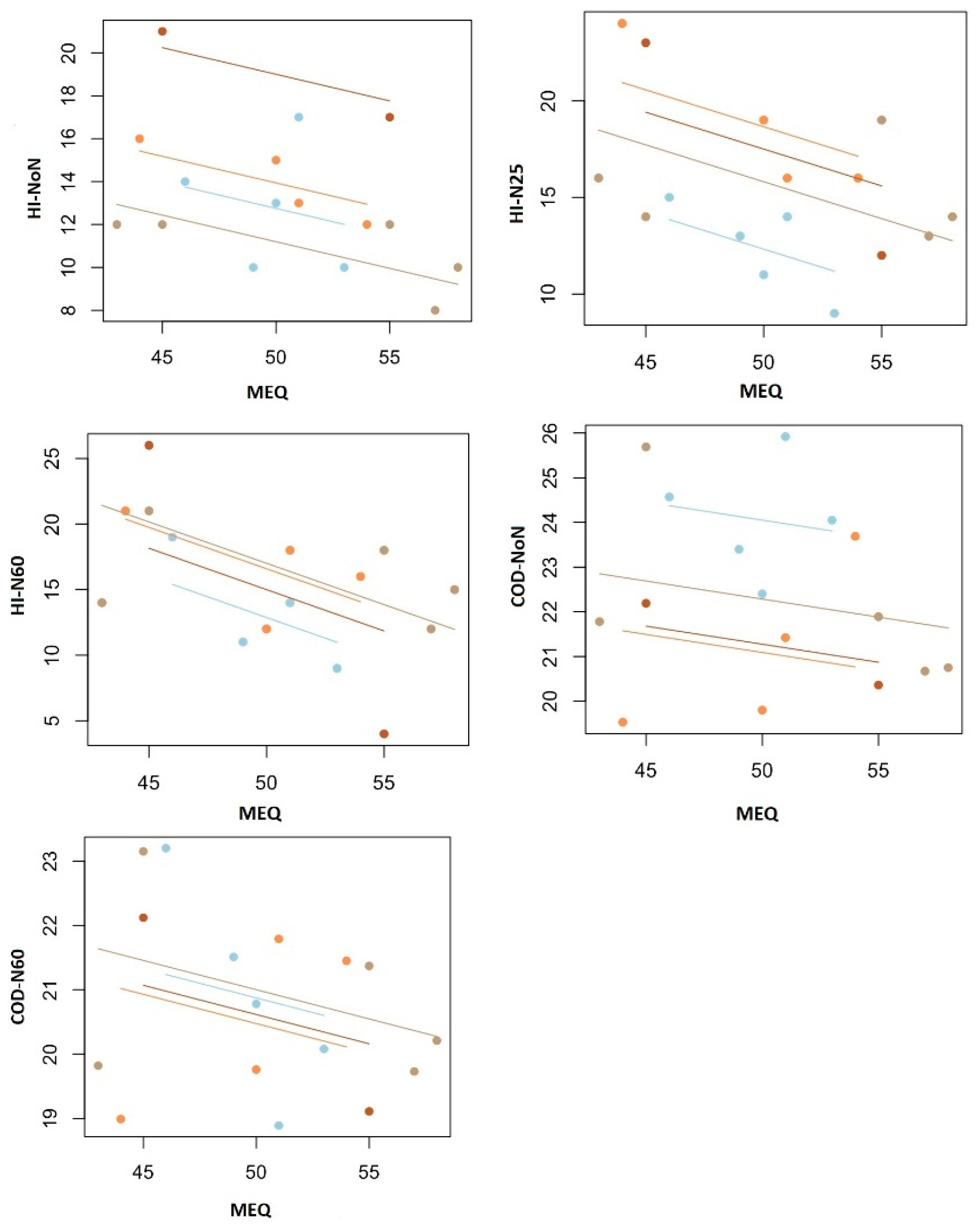
| Parameters | x ± SD | Min | Max |
|---|---|---|---|
| Age (year) | 17.18 ± 1.04 | 16.0 | 19.0 |
| Height (cm) | 179.06 ± 3.17 | 173.0 | 183.0 |
| Weight (kg) | 71.50 ± 7.16 | 60.0 | 85.0 |
| BMI (kg/m2) | 22.28 ± 1.98 | 19.10 | 26.50 |
| HR (beats) | 94.00 ± 14.38 | 64.0 | 120.0 |
| PSQI (score) | 5.37 ± 2.62 | 2.0 | 13.0 |
| PMSQ-Tension (score) | 14.12 ± 12.24 | 6.0 | 26.0 |
| PMSQ-Depression (score) | 14.31 ± 12.24 | 0.0 | 38.0 |
| PMSQ-Anger (score) | 13.56 ± 9.68 | 2.0 | 29.0 |
| PMSQ-Vigour (score) | 16.81 ± 5.92 | 3.0 | 23.0 |
| PMSQ-Fatigue (score) | 8.75 ± 5.48 | 0.0 | 20.0 |
| PMSQ-Confusion (score) | 8.31 ± 4.85 | 0.0 | 16.0 |
| PMSQ-Total Mood (score) | 42.25 ± 35.10 | −1.0 | 117.0 |
| MEQ (score) | 50.37 ± 4.75 | 43.0 | 58.0 |
| Participants | 1st Protocol | 2nd Protocol | 3rd Protocol |
|---|---|---|---|
| Participant 1 | NoN | N25 | N60 |
| Participant 2 | NoN | N25 | N60 |
| Participant 3 | NoN | N25 | N60 |
| Participant 4 | NoN | N60 | N25 |
| Participant 5 | NoN | N60 | N25 |
| Participant 6 | NoN | N60 | N25 |
| Participant 7 | N25 | NoN | N60 |
| Participant 8 | N25 | NoN | N60 |
| Participant 9 | N25 | NoN | N60 |
| Participant 10 | N25 | N60 | NoN |
| Participant 11 | N25 | N60 | NoN |
| Participant 12 | N60 | NoN | N25 |
| Participant 13 | N60 | NoN | N25 |
| Participant 14 | N60 | N25 | NoN |
| Participant 15 | N60 | N25 | NoN |
| Participant 16 | N60 | N25 | NoN |
| MEQ | JH1 | JH2 | JH3 | F1 | F2 | F3 | RF1 | RF2 | RF3 | P1 | P2 | P3 | RP1 | RP2 | RP3 | TV1 | TV2 | TV3 | I1 | I2 | I3 | FT1 | FT2 | FT3 | |
|---|---|---|---|---|---|---|---|---|---|---|---|---|---|---|---|---|---|---|---|---|---|---|---|---|---|
| MEQ | 1 | ||||||||||||||||||||||||
| JH1 | 0.12 | 1 | |||||||||||||||||||||||
| JH2 | −0.01 | 0.96 | 1 | ||||||||||||||||||||||
| JH3 | 0.09 | 0.91 | 0.94 | 1 | |||||||||||||||||||||
| F1 | 0.08 | 0.61 | 0.62 | 0.54 | 1 | ||||||||||||||||||||
| F2 | 0.01 | 0.60 | 0.64 | 0.55 | 0.99 | 1 | |||||||||||||||||||
| F3 | 0.02 | 0.55 | 0.60 | 0.54 | 0.98 | 0.99 | 1 | ||||||||||||||||||
| RF1 | 0.25 | 0.96 | 0.90 | 0.87 | 0.54 | 0.52 | 0.48 | 1 | |||||||||||||||||
| RF2 | 0.12 | 0.95 | 0.96 | 0.90 | 0.57 | 0.58 | 0.53 | 0.96 | 1 | ||||||||||||||||
| RF3 | 0.24 | 0.90 | 0.89 | 0.95 | 0.47 | 0.48 | 0.46 | 0.93 | 0.94 | 1 | |||||||||||||||
| P1 | 0.12 | 0.85 | 0.84 | 0.76 | 0.93 | 0.92 | 0.89 | 0.79 | 0.80 | 0.71 | 1 | ||||||||||||||
| P2 | 0.00 | 0.82 | 0.86 | 0.78 | 0.92 | 0.94 | 0.91 | 0.74 | 0.80 | 0.71 | 0.98 | 1 | |||||||||||||
| P3 | 0.06 | 0.78 | 0.83 | 0.81 | 0.91 | 0.92 | 0.92 | 0.71 | 0.76 | 0.73 | 0.95 | 0.97 | 1 | ||||||||||||
| RP1 | 0.18 | 0.99 | 0.94 | 0.90 | 0.59 | 0.57 | 0.52 | 0.98 | 0.96 | 0.91 | 0.83 | 0.79 | 0.75 | 1 | |||||||||||
| RP2 | 0.04 | 0.97 | 0.99 | 0.94 | 0.61 | 0.62 | 0.57 | 0.94 | 0.98 | 0.92 | 0.83 | 0.84 | 0.81 | 0.96 | 1 | ||||||||||
| RP3 | 0.15 | 0.92 | 0.93 | 0.99 | 0.51 | 0.53 | 0.51 | 0.90 | 0.93 | 0.98 | 0.74 | 0.75 | 0.79 | 0.91 | 0.94 | 1 | |||||||||
| TV1 | 0.11 | 0.99 | 0.97 | 0.92 | 0.63 | 0.62 | 0.57 | 0.96 | 0.96 | 0.90 | 0.86 | 0.84 | 0.80 | 0.99 | 0.97 | 0.92 | 1 | ||||||||
| TV2 | −0.02 | 0.96 | 0.99 | 0.94 | 0.64 | 0.64 | 0.61 | 0.90 | 0.96 | 0.89 | 0.85 | 0.87 | 0.83 | 0.94 | 0.99 | 0.93 | 0.96 | 1 | |||||||
| TV3 | 0.09 | 0.92 | 0.95 | 0.99 | 0.56 | 0.58 | 0.56 | 0.87 | 0.91 | 0.95 | 0.78 | 0.80 | 0.82 | 0.90 | 0.94 | 0.99 | 0.93 | 0.94 | 1 | ||||||
| I1 | 0.03 | 0.71 | 0.72 | 0.64 | 0.98 | 0.98 | 0.96 | 0.62 | 0.65 | 0.55 | 0.96 | 0.96 | 0.94 | 0.67 | 0.70 | 0.61 | 0.72 | 0.74 | 0.66 | 1 | |||||
| I2 | −0.05 | 0.68 | 0.74 | 0.65 | 0.96 | 0.98 | 0.96 | 0.58 | 0.65 | 0.54 | 0.94 | 0.97 | 0.95 | 0.64 | 0.70 | 0.61 | 0.70 | 0.75 | 0.67 | 0.98 | 1 | ||||
| I3 | −0.02 | 0.64 | 0.69 | 0.65 | 0.96 | 0.97 | 0.98 | 0.53 | 0.60 | 0.54 | 0.91 | 0.94 | 0.96 | 0.59 | 0.66 | 0.61 | 0.65 | 0.71 | 0.67 | 0.97 | 0.98 | 1 | |||
| FT1 | 0.10 | 0.99 | 0.97 | 0.92 | 0.63 | 0.62 | 0.57 | 0.96 | 0.96 | 0.90 | 0.90 | 0.84 | 0.80 | 0.99 | 0.97 | 0.93 | 0.99 | 0.96 | 0.93 | 0.72 | 0.70 | 0.65 | 1 | ||
| FT2 | −0.03 | 0.96 | 0.99 | 0.94 | 0.64 | 0.66 | 0.61 | 0.90 | 0.96 | 0.89 | 0.84 | 0.87 | 0.83 | 0.94 | 0.99 | 0.93 | 0.96 | 0.99 | 0.94 | 0.74 | 0.75 | 0.71 | 0.96 | 1 | |
| FT3 | 0.07 | 0.92 | 0.95 | 0.99 | 0.56 | 0.58 | 0.56 | 0.87 | 0.91 | 0.95 | 0.78 | 0.80 | 0.83 | 0.90 | 0.94 | 0.99 | 0.92 | 0.95 | 0.99 | 0.66 | 0.67 | 0.67 | 0.82 | 0.83 | 1 |
| MEQ | IT1 | IT2 | IT3 | COD1 | COD2 | COD3 | VAS2 | VAS3 | HI1 | HI2 | HI3 | |
|---|---|---|---|---|---|---|---|---|---|---|---|---|
| MEQ | 1 | |||||||||||
| IT1 | −0.05 | 1 | ||||||||||
| IT2 | −0.13 | 0.88 | 1 | |||||||||
| IT3 | −0.11 | 0.86 | 0.80 | 1 | ||||||||
| COD1 | −0.24 | 0.21 | 0.33 | 0.37 | 1 | |||||||
| COD2 | −0.16 | 0.63 | 0.66 | 0.73 | 0.64 | 1 | ||||||
| COD3 | −0.30 | 0.60 | 0.54 | 0.76 | 0.53 | 0.75 | 1 | |||||
| VAS2 | 0.07 | 0.14 | 0.30 | −0.11 | 0.08 | 0.18 | −0.02 | 1 | ||||
| VAS3 | 0.22 | −0.21 | −0.30 | −0.30 | −0.13 | −0.20 | −0.27 | 0.43 | 1 | |||
| HI1 | −0.55 | 0.00 | 0.11 | −0.05 | 0.25 | 0.10 | −0.00 | −0.02 | −0.17 | 1 | ||
| HI2 | −0.56 | −0.08 | −0.02 | 0.01 | −0.01 | −0.10 | 0.15 | −0.50 | −0.50 | 0.70 | 1 | |
| HI3 | −0.57 | 0.41 | 0.52 | 0.46 | 0.42 | 0.42 | 0.61 | −0.19 | −0.63 | 0.58 | 0.75 | 1 |
Disclaimer/Publisher’s Note: The statements, opinions and data contained in all publications are solely those of the individual author(s) and contributor(s) and not of MDPI and/or the editor(s). MDPI and/or the editor(s) disclaim responsibility for any injury to people or property resulting from any ideas, methods, instructions or products referred to in the content. |
© 2025 by the authors. Licensee MDPI, Basel, Switzerland. This article is an open access article distributed under the terms and conditions of the Creative Commons Attribution (CC BY) license (https://creativecommons.org/licenses/by/4.0/).
Share and Cite
Eken, Ö.; Öncü, M.; Kurtoğlu, A.; Bozkurt, O.; Türkmen, M.; Aldhahi, M.I. The Acute Effects of 25- Versus 60-Minute Naps on Agility and Vertical Jump Performance in Elite Youth Soccer Players: The Role of Individual Chronotype. Life 2025, 15, 422. https://doi.org/10.3390/life15030422
Eken Ö, Öncü M, Kurtoğlu A, Bozkurt O, Türkmen M, Aldhahi MI. The Acute Effects of 25- Versus 60-Minute Naps on Agility and Vertical Jump Performance in Elite Youth Soccer Players: The Role of Individual Chronotype. Life. 2025; 15(3):422. https://doi.org/10.3390/life15030422
Chicago/Turabian StyleEken, Özgür, Mertkan Öncü, Ahmet Kurtoğlu, Oguzhan Bozkurt, Musa Türkmen, and Monira I. Aldhahi. 2025. "The Acute Effects of 25- Versus 60-Minute Naps on Agility and Vertical Jump Performance in Elite Youth Soccer Players: The Role of Individual Chronotype" Life 15, no. 3: 422. https://doi.org/10.3390/life15030422
APA StyleEken, Ö., Öncü, M., Kurtoğlu, A., Bozkurt, O., Türkmen, M., & Aldhahi, M. I. (2025). The Acute Effects of 25- Versus 60-Minute Naps on Agility and Vertical Jump Performance in Elite Youth Soccer Players: The Role of Individual Chronotype. Life, 15(3), 422. https://doi.org/10.3390/life15030422






